BOL on BRAC ISLAND
Three
visits to Bol in 1934, 1960 and in September of 2002
Zvonko Springer, Salzburg, Austria, 2002
on this web with kind permission, 2005
The
first visit in 1934
Some 70
years ago my family of four visited BOL on ISLAND BRAC (read: Brach)
for the first time. I remember that we’ve travelled by train in a
sleeping car direct from our hometown Osijek via Zagreb to Split. Split is a large town with an important harbour
on Central
Adriatic.
The travel lasted whole night so we arrived to Split by mid morning of the next day. The railway
station is next to the harbour itself so after disembarking father
found a porter with a trolley for our luggage as we had to walk over
to a nearby hotel. We stayed in the hotel “Bacvice” that located
next to the gravel beach of the same name. At that time this hotel
was the only reasonably good hotel where we stayed for two nights.
Early
on the next morning the family embarked on a steamer that serviced
all harbours on Brac Island. I learned soon that we shouldn’t stay
on the stern becaus of black clouds with dirty particles coming out
of steamer’s smokestack. One used brown coal of low burning quality
for steam engines at the times in 1930s only. The sea voyage lasted
several hours as the ship tyed up at Supetar harbour at Island’s
north first and then at Milna long bay at west of Brac. We reached harbour of Bol amid Island’s south coast at last where we disembarked
well after the lunch time. I remember mother had served us sandwiches
and large peaches she bought on the marked in Split. We have had two rooms reserved in the
only hotel in Bol that was the "Hotel Kastil" (Castle).
From our rooms we have had a straight view onto the harbour below
the hotel that was located at the centre of Bol’s community too.
The same “Hotel Kastil” still exists although it was splendidly renovated
and considerably enlarged including a pleasant restaurant next the
esplanade now.
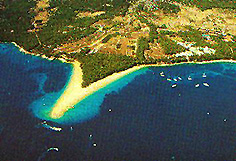
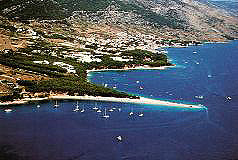
Left aerial view of the Golden Cape northward
and at right eastward (from Tourist Prospectus)
Here are
a few memories of Bol from my childhood. One of them is the long
and tedious walk from the hotel to the beach at Zlatni Rat (Golden Cape) only in part through a shadowed alley
of young pine trees. Sometimes father found a fisherman who would
take us in his two-oar boat on long trip to the Cape.
We had to walk back to the hotel always furtunately with almost empty
picnic baskets though. On another occasion father as a passionate
walker choose the long and steep pathway up the Vidova Gora (St.
Vitas Mountain). I’ve accompanied him on this trip ridding a donkey
all the way up and down this rather tedious path. We stopped at a
hermit’s dwelling where the old man showed us some ship models he
had constructed in bottles. One other day father took me to the Dominican
Monastery explaining where sons go for education if they are disobedient
and do not learn well. Was this to be a warning to me? Dominicans
were known as excellent educators and their students were accomodated
in their own boarding House throughout the whole school year. Now
Dominicans do not teach students anymore but they do provide boarding
facilities for visitors of various seminars held in their House.
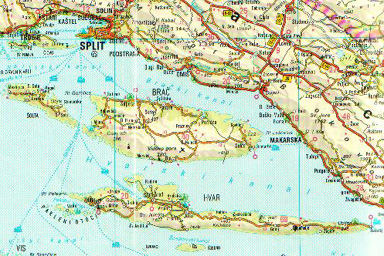
A cut out from a General
map showing the location of Island of Brac (read:
Brach)
Interlude
No.1 about
ISLAND OF BRAC (read: Brach)
BRAC is the largest of Central Dalmatian Islands and
the third largest one in the Adriatic and
has an area of 394,41km˛. To the North the wide BRACKI KANAL (Channel
of Brac) separates it from the Mainland. The channel of SPLITSKA
VRATA (Split’s
Entryway) is to the west of Brac and HVARSKI KANAL (Channel of Hvar)
stretches out along its south coastline. Brac is a typical limestone
formation with a steep northern coastline with more gentle slopes
at its southern side. The higher island’s regions have typical karsts’
forms such as cracks, cavities, funnel-shaped holes, ravines and
wider valleys at higher up levels only. The annual precipitations
vary between 800mm to 1.450mm with rains mostly during winter months.
Dominant winds are JUGO (Southerner) and BURA (Northerner) whereas
MAESTRAL is a more agreeable westerly wind blowing during hot summer
days.
On the island’s surface there are no open flowing watercourses and there
are no fresh water springs except at the village of Bol. The
inhabitants used to accumulate rain waters on levelled slightly sloped
flat surfaces and conserve it in house’s own cisterns. In recent
years Brac gets the fresh water from the Mainland by a pipeline submerged
and placed on the sea floor. The Island of Hvar gets
its fresh water supply from the same pipeline too.
Some larger zones of Black and Aleppo pines
are scattered at island’s higher regions at 400m ASL as well as at
some settlements on coastal stretches. The island’s flora consists
mainly of dense undergrowth, low shrubs, bushes or thorny hedging
plants on rocky surfaces. The sheep husbandry predominates here next
to the sea fishing industry. Agriculture products are olives (for
oil), grapes (vine) and other fruits particularly almonds and cherries.
The sheltered bays have sandy or beaches of fine sized gravel
but there are also many wild stone beaches where everybody to enjoy
swimming in crystal blue sea of Adria.
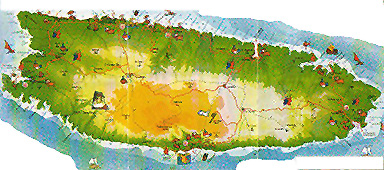
A detailed
map of Brac Island showing important places and roads (from
Tourist map)
Since the Neolithic times Brac was continually inhabited and so all the
way through the Bronze and Iron Ages. Brac first permanent inhabitants
were the Illyrians and island's ancient name BRATTIA probably derives
from Illyrian “brentos” as for a deer. The Romans left significant
cultural traces in island’s interior as well as along its coastal
stretches. The limestone quarry at Skrip (Brac’s marble) is still
being exploited and the stone from it was used for the construction
of Diocletian’s palace in Split too.
Subsequently Byzantine ruled over the island until the Neretvian
tribe occupied the Island in 9th century to link up
with the Croatian Kingdom later.
During following times inhabitants had to move up to higher up grounds
at the interior because of constant danger and raids by sea pirates.
The settlements like Nerezisce, Humac, Skrip, Gradac etc. became
their safe havens on Island's highlands. The Clan of Omis
from Mainland took hold of Brac that was Split metropolitan area
by mid of 13th century.
The Kings of Hungarian-Croatian and of Bosnian states ruled over the
island during the 14th century until the Serenissima alias State of Venetia seized
it. Venetia had confirmed Island’s
old privileges so some new settlements developed under its sovereignty
on the coast like Sutivan or Povja as from 1420 to 1797. The old
settlements in the interior lost their importance as residents moved
down to the coast gradually. After Venetia’s decline around 1797 it was
the Austro-Hungarian Monarchy that stepped in 1806 by taking over
the Island. For
a short while Brac was Russian fleet’s basis until Napoleon established
the French authority there that didn’t last for too long. Afterwards
Monarchy took over the full control in the Adriatic Sea again
that ended permanently with the end of World War I. in
1918. Afterwards Brac Island came
under the sovereignty of the Kingdom of Yugoslavia lasting
until mid of 1941. Partisans clashed sporadically with Italian and
German occupation forces during the World War II. Brac was liberated
by Tito’s Yugoslav People Army in September 1944.
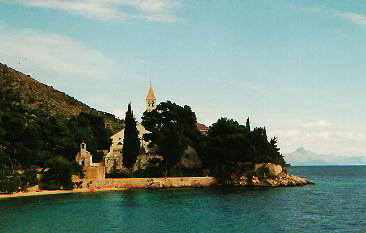
View
at the Dominican Monastery with a beach in front left and Mainland
in background
At present there are 22 inhibited towns and villages on Brac. The most
important ones are Supetar, Splitska, Postira, Povja, Selca, Sumartin,
Bol, Milna, Sutivan, Sumartin and others. These are of particular
interests or present special attractions to the visiting tourists.
* * * * *
The
second visit in 1960
My second visit to Bol was in summer 1960 when my family
spent a 2-week holiday there. Before that in fall of 1959 we moved
into our own flat of 52 m˛ though it was small and not too comfortable.
For the first time we could live within on our own "four walls" since
our marriage in 1951. Our daughter Vesna (6) got a new companion
that was our first dog named “Lucky”, a Cocker Spaniel. Lucky was
in his "teens" and had a long fur of black/grey/white spotted
colour. Three of us plus Lucky shared one compartment in a sleeping
railway wagon from Zagreb to Split. At those days it was quite unusual that somebody travels
by train taking a dog with. One needed a special permission for a
dog and to be lucky having understanding fellow passengers in a railway
compartment during the voyage. Early next morning we disembarked
at Split Railway Station that was there next to the harbour as 26
years ago.
We had to choose that the arrival to Split coincides
with ship’s departure to Brac. It was a steam ship from that smokestack
wafted black clouds with dirty particles again. We found a sheltered
place at the foredeck where we had our breakfast enjoying a pleasant
breeze and the sight of a blue sea everywhre. We had to keepon leach
a rather excited Lucky to control his movement on the ship deck.
We got the accommodation in a rather venerable looking “Hotel Kastil” then. From our room we’d overlook
the harbour’s wharf and the esplanade in front below.


Left a group stopped on the
way to Golden Cape and
right the author with Lucky at the beach
We
had walked the same pathway to Golden Cape beach though the Aleppo pine alley provided more
shade now. The trees grew larger during the past 26 years since my
first visit to Bol in early 1934. We have had problems with Lucky
swimming and rushing around the beach as some visitors grumbled about
a dog bathing at place designated to people only. Often we had to
find a place where visitors were more considerable or we found a
flat rocky beach for ourselves only. Lucky was a very happy young
dog those days enjoying immensely the swimming and long walks too.
The climate and a good appetite made Lucky to grow fast reaching
the height of a Springer Spaniel after his holidays on the Adriatic. By summer of 1961 we
got rather busy making preparations for our departure to the Sudan. We had to give Lucky
away to a new master who was a dedicate hunter near Cakovec at Croatia’s north where Lucky found
the proper domain for a hunting dog he was.
Interlude
No. 2 about
BOL ON BRAC ISLAND
BOL is
the oldest settlement on Brac on its south coast sheltered below
a mountain range of BOLSKA KRUNA (Crown of Bol). Thus Bol is sited
at the foot of VIDOVA GORA (St. Vitas Mountain) that peak is at +778m
ASL and the highest of all Adriatic islands. Next to is DRAŽEVA HILL
(+627m ASL) with the Illyrian hill-fort of KOŠTILO at +600m ASL.
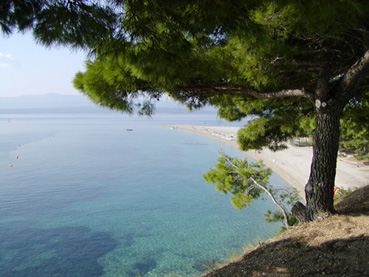
On
the way to the Golden Cape the
view on Cape's
eastern beach site (Photo Jutta Menke)
The settlement
of Bol spreads along a fertile declivity in that several fresh-water
springs bubble out from the mountain range at a rear. There are numerous
beaches that stretch for some 15km from MARTINICA Bay at east to
BLACA Bay at west of Bol. The most famous of all is ZLATNI RAT (Golden Cape) that beach consists mainly of almost
spherical small gravels. The Cape’s tip moves to and fro about 50cm following
wind and tidal movements twice a day. The Golden Cape is probably the most beautiful beach in
the Adriatic.
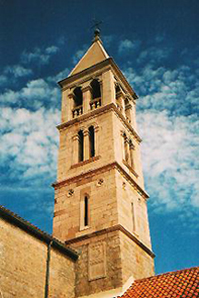
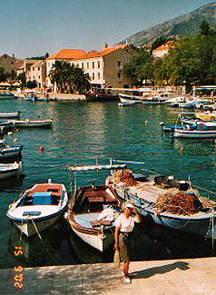
Left Tower of Church of Our Lady of
Mercy Right inner
harbour "Hotel Kastil" in background
Saracens
destroyed the first settlement of Bol in year 827. Archaeologists
found many tombstones, stone relief and reservoirs from Roman times.
There are few early Christian sarcophaguses and ornamental carvings
from Old Croatian period too. One discovered remnants of an antique
building complex near the small Church of St. John that date back to the Old Croatian era
in 11th Ctr. The Bishop’s Palace is here in Bol since 12th Ctr.and
the Dominican Monastery has been constructed in 15th Ctr. The Church
of Our Lady of Mercy took long to be build as from 15th to 17th Ctr.
The Tower to that Church was completed by 1751. The Museum of the
Monastery preserves an important collection of incunabula and other
old books, ancient weaponry, old watches and clocks, astronomical
instruments, a large numismatic compilation and some more ethnographic
objects. In Bol one can view a fortified gothic Summer Residence
from early 16th Ctr. Also a Mansion constructed in Renaissance and
Baroque style by end of 18th Ctr. The Church of Our Lady of Mt. Carmel
(in late Renaissance style) has been build about the same time.
Several
daily excursions start from Bol to Split, Dubrovnik, Makarska, Jelsa and Vrbovska on Island
Hvar and onto Island Mljet. When visiting to the sandy bay of Blaca one should take time to view the best
preserved complex of the former Glagolic architectural and the monumental
heritage on Brac Island. DRAKONJINA SPILJA (Dragon’s Cave) is
located west of Bol above the small village of Murvica and stores a number of dragon’s stone
relief and other cultic figures.
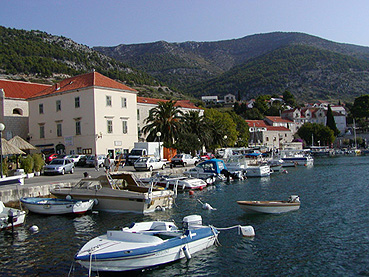
View at the inner harbour
and the centre of community Bol
(Photo Jutta Menke)
* * * * *
The
third visit in 2002
We planned
a visit to Bol for September 2002 to meet good friends there and
to visit my sister on Hvar Island. We have had the chance to fly from Salzburg straight to the new airport on Brac and
the flight took a little less than two hours. It was pitch dark when
the charter aircraft put down smoothly on a landing strip of Brac
airport built on its Highlands at +580 ASL almost at its centre too.
The bus had to drive rather slowly down a steep tarmac road with
too many serpentines until it reached the coastline. Bol has a fast
connection by a hovercraft ship from Split during the main season twice daily linking
to Hvar and Vis islands too. There is also a ferryboat
link from Split to Supetar for those who prefer travelling
in own vehicles. A tarmac road from Supetar leads to all major places
on the Island. It has to cross the mountain range via
Nerežišca and Praznica to reach Bol on opposite island’s side.
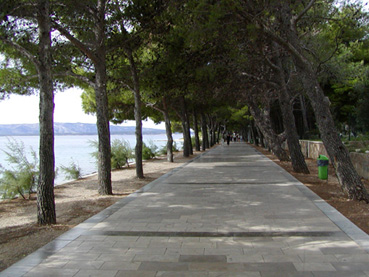
The
nice walkway from Bol's centre to the Golden Cape alias
Zlatni Rat (Photo Jutta Menke)
The community
of Bol expanded westward from its old centre in the wake of touristic
development in recent years fast. Several hotels located close to
the Golden Cape had been erected since. Now many more
visitors find good accommodation there including a number of private
lodgings in recently built private houses. The hotels have maximum
three stories and are well hidden within Aleppo pine-tree wooded areas. Let me mention
a few like “Bretanide”, “Bonaca”, “Borak” and “Elaphusa” in the later
we stayed during my third visit here. The new pathway from Bol centre
to Golden Cape is wide enough even for a one-way road.
It is nicely constructed of local marble flagstones and set out along
the Aleppo pine-tree alley of a length about 1,5km.
It provides a pleasant shade even during hottest summer days.

View at the eastern beach
of the Golden Cape alias Zlatni Rat

View
towards the Golden Cape and Island of Hvar in
background
Our 7-day
stay was by too short to undertake any excursion on Brac itself.
We wouldn't be able to walk up to Vidova Gora peak to enjoy the splendid
view there anymore. There is an easier chance of doing this trip
in a 4-wheel drive vehicle now. The old monastery of Blace suffered
a lot during the past war and is a ruin only. We walked over to the
Dominican monastery but they don't have a school for students anymore.
There are several good restaurants at the centre and a small vehicular
train tours to and fro to the Golden Cape almost every hour. As for the restaurant
I would recommend the one of “Hotel Kastil” and the other one opposite
to the monastery (next to “Hotel Bijela Kuca” that is out of commission
for a while).
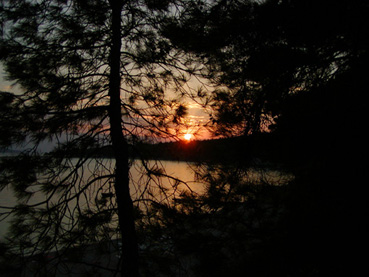
Sunset over
the Golden Cape (Photo
Jutta Menke)
After
visiting the same place within a time range of almost 70 years have
awakened in me many reminiscences on memories and feelings of bygone
times. Considering the experiences of my own childhood and the ones
of weathered manhood have made me - a grey & thin haired elder
- rather sensitive to the long passed by times.
Literature:
JADRAN – Vodic i Atlas of RADE KONCAR Zagreb published by Leksikografski
Zavod, Zagreb 1965 et Al.














